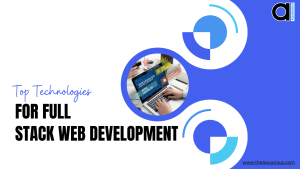Top Technologies for Full Stack Web Development

In today’s rapidly evolving digital landscape, web development plays a pivotal role in creating powerful and engaging online experiences. Full-stack web developers for hire, in particular, involves working on both the front-end and back-end aspects of a website or web application. To excel in this field, it’s crucial to stay updated with the latest technologies and tools that enable seamless development. In this article, we will explore the top technologies for full-stack web development and their significance in building robust and feature-rich web solutions.
Introduction to Full Stack Web Development
Full-stack web development involves working on both the client-side and server-side components of a web application. Full-stack web developers for hire are proficient in front-end technologies such as HTML, CSS, and JavaScript, as well as back-end technologies like databases and server-side frameworks. This expertise allows them to handle the entire development process, from designing user interfaces to implementing complex server-side logic.
Hypertext Markup Language, CSS (Cascading Style Sheets), and JavaScript form the core foundation of web development. The former provides the structure and content of a web page, while CSS is responsible for its visual presentation. JavaScript, on the other hand, adds interactivity and dynamic behaviour to web applications.
Front-End Frameworks for Enhanced User Interfaces
Front-end frameworks such as React, Angular, and Vue.js have gained immense popularity in recent years. These frameworks provide developers with a set of pre-built components and libraries, simplifying the process of creating interactive user interfaces. They also offer features like state management, routing, and data binding, which enhance the overall development experience.
Back-End Technologies for Data Processing and Server-Side Logic
When it comes to back-end development, several technologies and frameworks are widely used. Node.js, for example, allows developers to build scalable and efficient server-side applications using JavaScript. Other popular back-end frameworks include Django (Python), Ruby on Rails (Ruby), and Laravel (PHP), each offering its own set of advantages and features.
Databases for Efficient Data Management
Data management is a crucial aspect of web development. Full-stack developers work with databases to store, retrieve, and manipulate data. Relational databases like MySQL and PostgreSQL are commonly used for structured data, while NoSQL databases like MongoDB and Cassandra excel at handling unstructured and semi-structured data. Additionally, technologies like GraphQL provide efficient querying capabilities for APIs.
Version Control Systems for Collaborative Development
Version control systems such as Git enable developers to track changes in their codebase and collaborate effectively. By using Git, developers can create branches, merge code, and roll back changes if needed. Platforms like GitHub and Bitbucket further enhance collaboration by providing hosting and project management features.
API Development and Integration
APIs (Application Programming Interfaces) enable different software systems to communicate and exchange data. Full-stack developers often work with RESTful APIs or GraphQL to develop and integrate functionalities into their web applications. Well-designed APIs allow seamless integration with external services and enable the development of scalable and modular applications.
Testing and Debugging Tools for Quality Assurance
Ensuring the quality and reliability of web applications is paramount. Full-stack developers utilize testing frameworks like Jest, Mocha, and Jasmine to write unit tests, integration tests, and end-to-end tests. Debugging tools like Chrome DevTools help identify and resolve issues during development, ensuring a smooth user experience.
Deployment and Hosting Platforms
Deploying web applications requires suitable hosting platforms. Services like Heroku, AWS (Amazon Web Services), and Microsoft Azure provide a scalable and reliable infrastructure for hosting web applications. Developers can choose the platform that best suits their needs, considering factors such as scalability, cost, and ease of deployment.
Security Measures for Web Applications
Web application security is a critical aspect of full-stack web development. Developers must implement secure coding practices and utilize measures such as input validation, authentication, and authorization. They should also stay updated with the latest security vulnerabilities and adopt security best practices to protect user data and ensure a secure browsing experience.
Performance Optimization Techniques
Optimizing web application performance is essential for delivering a seamless user experience. Techniques such as minification, caching, lazy loading, and code bundling help reduce load times and improve overall performance. Full stack developers should optimize both the front-end and back-end components to achieve optimal performance.
Responsive Design and Mobile Compatibility
With the increasing usage of mobile devices, web applications must be responsive and mobile-friendly. Responsive design techniques ensure that web pages adapt to different screen sizes and provide a consistent experience across devices. Full stack developers should incorporate responsive design principles and test their applications on various devices to ensure compatibility.
Progressive Web Applications (PWAs) for Enhanced User Experience
Progressive Web Applications (PWAs) combine the best features of web and mobile applications, offering users an app-like experience within a web browser. PWAs can work offline, send push notifications, and provide a seamless user experience across different platforms and devices. Full-stack developers can leverage technologies like Service Workers and Web App Manifests to build PWAs.
Serverless Architecture and Cloud Computing
Serverless architecture and cloud computing have revolutionized web development. Platforms like AWS Lambda and Microsoft Azure Functions allow developers to build and deploy applications without managing servers. This approach enables scalability, reduces infrastructure costs, and simplifies the development and deployment process.
Microservices and Containerization
Microservices architecture and containerization have gained popularity due to their scalability and flexibility. The former involves breaking down an application into smaller, independently deployable services. Containerization technologies like Docker provide a consistent and isolated runtime environment for these services. Full stack developers can leverage microservices and containers to build modular and scalable web applications.
Conclusion
Full-stack web development requires a diverse skill set and knowledge of various technologies. By staying updated with the top technologies discussed in this article, developers can build powerful and efficient web applications. Whether it’s front-end frameworks, back-end technologies, databases, or deployment platforms, each technology plays a crucial role in creating exceptional online experiences. As the digital landscape continues to evolve, full-stack developers must embrace these technologies to stay ahead and deliver innovative solutions.
Aquarious Technology offers a team of skilled full-stack web developers for hire, equipped with the expertise to leverage the top technologies in web development and create robust and scalable solutions. With Aquarious technology, businesses can access experienced professionals who excel in front-end and back-end development, ensuring a seamless and efficient full-stack web development process.
-
14
+Category
-
98
+Post
Top Categories
Popular Posts
- The Power of Prototyping in Software Development
- Version Control Best Practices for App Development
- Understanding Visual Hierarchy: A Guide to Effective Design
- Crafting Intuitive Navigation: A Guide to Seamless User Experience
- Choose Your Best Cloud Provider
- Making the Leap: Transitioning from Manual to Automated Software Testing
- Using GitHub- Advantages and Disadvantages
- E-commerce Product Photography on a Budget
- Tech Innovation in Developing Countries
- Smart Cities: How Technology is Shaping the Urban Landscape
- Principles of Composition: Creating Visual Harmony with Composition
- Exploring Cross-Platform App Development
- Why Regular Website Updates Matter
- Navigating Effective Facebook Audience Targeting
- Implementing Ads for Game Monetization
- Designing User-Centric Mental Health Apps: Enhancing Well-being in the Digital Age
- NFTs and Collectibles: Creating NFT App Solutions for Collectors and Enthusiasts
- Successful Implementation of Enterprise Apps
- Maximizing Business Impact with EQ
- Proven SMO Ads Optimization Tips (2023)






